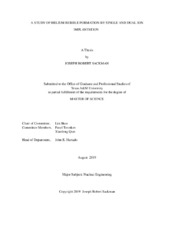| dc.contributor.advisor | Shao, Lin | |
| dc.creator | Sackman, Joseph Robert | |
| dc.date.accessioned | 2019-11-20T22:02:15Z | |
| dc.date.available | 2019-11-20T22:02:15Z | |
| dc.date.created | 2019-08 | |
| dc.date.issued | 2019-05-16 | |
| dc.date.submitted | August 2019 | |
| dc.identifier.uri | https://hdl.handle.net/1969.1/186147 | |
| dc.description.abstract | Helium bubble formation in materials is a concern for both modern day nuclear reactors as well as the next generation. Helium trapped in an atomic lattice has a tendency to form bubbles that may cause blisters, flaking, and increased porosity on the surface of a material. For this experiment a 10 kV linear accelerator was rebuilt and joined with a 1.7 MV linear accelerator to create a system where multiple ion species could be implanted in a sample material simultaneously. This dual ion beam system was used to examine the development of helium bubbles in stainless steel under both helium only implantation and helium with simultaneous implantation of a heavier ion species. It was observed in both a 5.0·10¹⁵ and 3.0·10¹⁶ ions·cm⁻² implantation that the additional damage from a second iron ion caused an increase in helium bubble nucleation across the entire range of 10 keV He⁺ in a 316L stainless steel target. | en |
| dc.format.mimetype | application/pdf | |
| dc.language.iso | en | |
| dc.subject | helium bubbles | en |
| dc.subject | linear accelerator | en |
| dc.subject | dual beam | en |
| dc.title | A Study of Helium Bubble Formation by Single and Dual Ion Implantation | en |
| dc.type | Thesis | en |
| thesis.degree.department | Nuclear Engineering | en |
| thesis.degree.discipline | Nuclear Engineering | en |
| thesis.degree.grantor | Texas A&M University | en |
| thesis.degree.name | Master of Science | en |
| thesis.degree.level | Masters | en |
| dc.contributor.committeeMember | Tsvetkov, Pavel | |
| dc.contributor.committeeMember | Qian, Xiaofeng | |
| dc.type.material | text | en |
| dc.date.updated | 2019-11-20T22:02:15Z | |
| local.etdauthor.orcid | 0000-0002-8777-3510 | |


